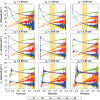Evaluation of layered tissue scattering properties: a time-domain spatially resolved spectroscopy approach
- PMID: 40692847
- PMCID: PMC12279310
- DOI: 10.1117/1.JBO.30.7.075002
Evaluation of layered tissue scattering properties: a time-domain spatially resolved spectroscopy approach
Abstract
Significance: The spatially resolved spectroscopy (SRS) approach is widely used in continuous wave near-infrared spectroscopy to estimate tissue oxygen saturation in the skeletal muscle and cerebral cortex. The extension of the SRS approach to the time domain (TD) has never been proposed. We hypothesize that the time-domain spatially resolved spectroscopy (TD SRS) approach, relying on simple models and linear fit, avoiding nonlinear model-based analysis approaches, could be able to assess the homogeneity of the scattering of the explored tissue.
Aim: We aim to explore the potential of the TD SRS approach for estimating from the spatial derivative of the measured signal in a homogeneous and in a two-layer medium and by considering also the effect of the instrument response function (IRF).
Approach: A theoretical expression for depending on the spatial derivative of the attenuation is derived. Then, numerical simulations are conducted using solutions of the radiative transfer equation under the diffusion approximation. We consider a reflectance geometry with source-detector distance in the range 1 to 5 cm in 0.5 cm step, either in a homogenous semi-infinite or two-layer diffusive medium. Convolution with a real IRF is also carried out to mimic experimental scenarios.
Results: In a homogeneous medium, the TD SRS approach is able to retrieve over a large range of values, being minimally affected by the IRF. In a two-layer medium, the TD SRS approach can only provide information on the changes of with depth but fails to provide a robust estimate of the absolute value of in either of the two layers. Moreover, the IRF can greatly affect the results in the case of the two-layer medium.
Conclusions: The TD SRS approach can be a simple way to estimate spatial changes of but not the absolute value of . Care should be taken to use a TD system with proper IRF.
Keywords: reduced scattering coefficient; spatially resolved spectroscopy; time domain; two-layer diffusive medium.
© 2025 The Authors.
Figures














References
-
- Suzuki S., et al. , “Tissue oxygenation monitor using NIR spatially resolved spectroscopy,” Proc. SPIE 3597, 582–592 (1999). 10.1117/12.356862 - DOI
-
- Cowdrick K., “NIRS & DCS commercially available product landscape,” 2023, https://datastudio.google.com/reporting/5f333396-7078-4f31-9056-e0f926b9....
Publication types
MeSH terms
Substances
LinkOut - more resources
Full Text Sources

